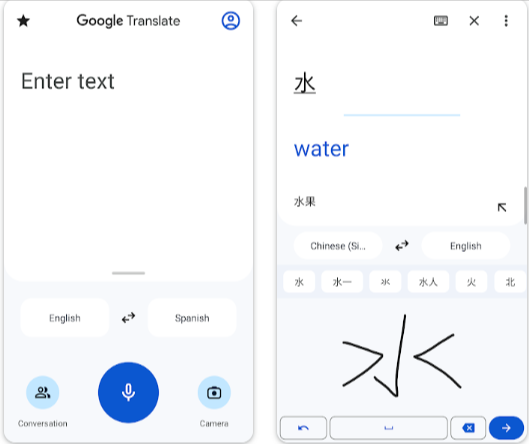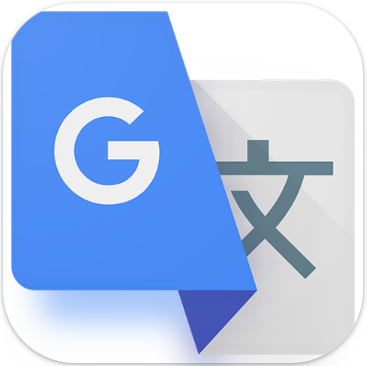Discover how the Google Translate App breaks language barriers with features like text, voice, and camera translation. Learn real-life use cases, benefits, limitations, and how it compares with other translation apps to make global communication easier.
1. Introduction – The Need for a Translation Solution
Consider being in a new country where you cannot read signs, have a hard time with menus and can barely understand locals. Or envisage a global corporate gathering where people do not understand each other and they end up missing out. These scenarios identify a common test one faces in the context of language barriers –
This is where Google Translate App is an effective tool in the form of translation of languages in order to connect the difference between cultures. It is an interpreter you can take with you anytime anywhere and use when you find it necessary to interact with foreigners.
The main reason why Google Translate App is so popular is not its free cost, but the ability to get a real-time translation in 100+ languages, support of various communication channels (text, voice, camera, conversation) and a constant process of improvement via AI-enhancement. In the contemporary world of globalization where communication through borders is becoming more relevant than ever before, this tool has become a popular staple among the millions of people, who are interested in having fast, reliable, and accessible translations.
2. Google Translate App? What is it?
The Google Translate App is a free-of-charge translation app formulated by Google to be used in facilitating communications amidst different languages. It is cross-platform so it can be used on iOS and Android devices as well as Web browsers, ensuring accessibility anywhere globally.
- Purpose: It is used to offer instant translation of words, sentences or even paragraphs in different languages.
- History: Google Translate was launched in 2006 as a web-based service, but it has since evolve a great deal. It has added a more accurate and natural sounding translations, changing from simple text translations, to containing built in neural machine translation (NMT).
- Machines: Currently, more than 100 languages are supported, and the application is among the most popular translation solutions around the world.
Such a continual development is an indication of the commitment Google has made to ensure a more connected world where people can no longer use language as a barrier.
3. Key Features of Google Translate App
The popularity of the Google Translate App is explained by a broad gamut of its features that is not confined to traditional text translation. Its core capabilities are the following:
Text Translation
- Text you copy or paste gets translated into more than 100 languages.
- Perfect screensize to access mail, study material or search quickly.
Voice Translation
- Talk into your phone and receive instant translations into different language.
- The best language to talk to locals when a person is traveling or to communicate in a multilingual meeting.
Camera Translation
- Just then point your phone camera at a sign, menu or document and the application renders a translation of it on the phone.
- Extremely useful in restaurants, the Metro and orienting yourself in strange streets.
Offline Mode
- Download local files with language packs and translate when you are offline.
- Great access to travelers in distant portions of the world or in under-connected countries.
Conversation Mode
- Allows conducting two-way, multilingual conversations with instant voice translation.
- Solves communication obstacles as they arise.
Phrasebook
- Place common phrases that you use frequently everywhere.
- Perfect to those who frequently talk of the words, “thank you,” “hello,” or “how much?”
All these features give the Google Translate App more than tool status it is becoming a pocket translator.
4. The Merits of Using Google Translate App
The Google Translate App has a number of exclusive advantages that transform it into a must-use tool to communicate globally:
Convenience
- Instantly translates on the go, conversations, documents or signs.
- Is time- and effort-saving as opposed to conventional dictionaries or phrasebooks.
Accessibility
- Easy to use interface that will be accommodative to both the tech-savvy and non-tech-savvy users.
- Allows voice and scanning camera translation in order to accommodate individuals that do not like typing.
Cost-Effective
- No subscription fee and it is absolutely free.
- Provides high-value translation at an affordable cost.
Cross-Cultural Communication
- Enables the people of different countries to communicate freely
- Increases education, business partnership and tourism.
The app has helped solve the problem of connecting with anyone across nations because of the absence of a language barrier.

5. Limitations and Challenges
While the Google Translate App is powerful, it does have limitations:
- Accuracy Issues
- Struggles with complex sentences, idioms, and slang.
- Translations may not always reflect cultural nuances.
- Struggles with complex sentences, idioms, and slang.
- Limited Dialect Support
- While major languages are supported, some regional dialects and rare languages may be less accurate.
- While major languages are supported, some regional dialects and rare languages may be less accurate.
- Internet Dependency
- Certain features, like live conversation mode, require a strong internet connection.
- Offline mode works, but may not always offer the same accuracy.
- Certain features, like live conversation mode, require a strong internet connection.
- Privacy Concerns
- Since text and voice data may be sent to servers for processing, sensitive information could raise data privacy issues.
- Since text and voice data may be sent to servers for processing, sensitive information could raise data privacy issues.
Despite these challenges, it remains one of the most trusted translation apps worldwide due to constant updates and improvements.
6. Tips for Maximizing the App’s Potential
To get the most out of the Google Translate App, follow these tips:
- Download Offline Packs: Always download the languages you need before traveling.
- Use Camera Translation: Helpful for reading menus, road signs, or product labels instantly.
- Pair with Learning Tools: Use it alongside language-learning apps for deeper understanding.
- Regular Updates: Keep the app updated to access new features and improved AI accuracy.
- Practice Short Sentences: Breaking long sentences into smaller ones increases accuracy.
These hacks make the app not just a tool, but a smart companion for global communication.
7. Real-Life Use Cases
The Google Translate App is not just a tool for occasional word lookups—it has become a lifesaver in countless real-world situations. From travel adventures to business meetings and even emergencies, this app empowers people to communicate when language would otherwise be a barrier. Let’s explore some of the most common and impactful use cases:
✈️ Travel and Tourism
One of the most common ways people use the Google Translate App is while traveling to foreign countries. Tourists often encounter situations where local language knowledge is limited, and the app steps in to bridge the gap.
- Menus & Food Orders: Travelers can use the camera translation feature to scan menus and instantly see translations of dishes. This helps avoid ordering something unexpected or unsafe for dietary needs.
- Street Signs & Directions: With live translation through the camera, tourists can understand road signs, maps, and even museum descriptions.
- Basic Conversations: Whether asking for directions, booking a taxi, or checking into a hotel, the app’s conversation mode allows for real-time communication with locals.
👉 For travelers, the Google Translate App transforms confusion into confidence.
🎓 Language Learning for Students
Students learning a new language often use the app as a supportive tool alongside their studies. While not a replacement for deep learning, it acts as a personal assistant for quick understanding.
- Homework Help: Students can check the meaning of new words and phrases quickly.
- Pronunciation Practice: With the voice playback feature, learners can hear how words are pronounced by native speakers.
- Phrasebook Tool: By saving useful phrases, students can build a personalized dictionary for regular practice.
👉 The Google Translate App becomes a language companion for students, making learning faster and more interactive.
💼 Business and Professional Communication
In today’s globalized world, businesses often deal with international partners, clients, and suppliers. Here, the Google Translate App becomes a cost-effective alternative to hiring human translators for basic communication.
- Emails & Documents: Professionals use the app to quickly translate short documents, instructions, or email messages.
- Meetings with Clients: The conversation mode helps in communicating during meetings when both parties don’t share a common language.
- Customer Support: Businesses can interact with foreign customers more effectively, providing better service.
👉 For companies expanding globally, the Google Translate App supports smoother and faster communication.
🚑 Emergency Situations
Sometimes, communication isn’t just about convenience—it can be a matter of safety. In emergencies, the Google Translate App can be a critical tool.
- Medical Emergencies Abroad: If a traveler gets sick or injured in a foreign country, the app helps in explaining symptoms to doctors.
- Police or Legal Assistance: In cases where individuals need help from authorities, quick translations can reduce misunderstandings.
- Disaster Relief: Aid workers and volunteers often use the app to communicate with locals in crisis zones.
👉 In urgent situations, the Google Translate App can literally save lives.
🏡 Daily Life for Expats
People living abroad face everyday challenges in adjusting to new cultures and languages. The app helps them integrate more smoothly.
- Shopping & Bills: Understanding product labels, utility bills, or contracts becomes easier with camera and text translation.
- Schools & Communities: Parents can communicate with teachers or neighbors when there’s a language gap.
- Healthcare & Services: Booking appointments, filling prescriptions, or handling paperwork is more accessible.
👉 For expats, the app serves as a daily survival kit.
✅ In summary, the Google Translate App has countless real-life applications—from travel and study to business and emergencies. Its versatility proves that it’s not just a handy app but a powerful global communication tool that adapts to people’s needs in different situations.
8. Comparison with Other Translation Apps
When it comes to breaking language barriers, there are several translation apps available, but the Google Translate App continues to stand out as one of the most widely used tools worldwide. To better understand its strengths and weaknesses, let’s compare it with a few popular alternatives such as Microsoft Translator, DeepL, and iTranslate.
🔹 Google Translate App vs. Microsoft Translator
- Similarities:
- Both support text, voice, and image translations.
- Available on iOS, Android, and web platforms.
- Offer offline translation packs.
- Both support text, voice, and image translations.
- Differences:
- Google Translate App supports over 100 languages, while Microsoft Translator supports around 70 languages.
- Microsoft Translator integrates seamlessly with Microsoft products like Office 365 and Teams, making it great for business users.
- Google Translate shines in real-time translation and has a broader user base, meaning continuous AI improvements.
- Google Translate App supports over 100 languages, while Microsoft Translator supports around 70 languages.
👉 Verdict: If you need wide language coverage and instant camera translation, Google Translate App is the winner. For corporate environments, Microsoft Translator may have an edge.
🔹 Google Translate App vs. DeepL Translator
- Similarities:
- Both use artificial intelligence for translation.
- Easy-to-use interface for quick translations.
- Both use artificial intelligence for translation.
- Differences:
- DeepL is praised for its high accuracy in European languages like German, French, and Spanish, often outperforming other apps in grammar and context.
- Google Translate App, however, covers many more languages (100+) compared to DeepL’s limited list (around 30+).
- Google also offers conversation mode and camera-based translation, which DeepL currently lacks.
- DeepL is praised for its high accuracy in European languages like German, French, and Spanish, often outperforming other apps in grammar and context.
👉 Verdict: If your focus is contextual accuracy in European languages, DeepL is great. But for global communication and travel, Google Translate App is far more versatile.
🔹 Google Translate App vs. iTranslate
- Similarities:
- Both apps provide voice translation and text translation.
- Offer offline mode for selected languages.
- Both apps provide voice translation and text translation.
- Differences:
- iTranslate’s free version is quite limited, while Google Translate App offers most of its powerful features for free.
- iTranslate Pro has unique features like website translation and dialect switching, which can be handy for specific users.
- Google Translate has the advantage of live camera translation, real-time conversation mode, and a much larger phrasebook.
- iTranslate’s free version is quite limited, while Google Translate App offers most of its powerful features for free.
👉 Verdict: iTranslate is a decent choice if you want dialect customization, but for everyday usage, Google Translate App is more practical and cost-effective.
🔹 Why Google Translate App Stands Out
Compared to its competitors, the Google Translate App stands out because of:
- Wider language support (100+ languages).
- Free access to most advanced features.
- AI-powered real-time translations for text, speech, and images.
- Accessibility across platforms (iOS, Android, and web).
- Constant improvements thanks to Google’s AI research and vast user feedback.
✅ In short, while apps like Microsoft Translator, DeepL, and iTranslate offer valuable features, the Google Translate App remains the most versatile and globally accessible translation tool. Its combination of accuracy, convenience, and extensive language coverage makes it the go-to choice for travelers, students, and professionals who need quick and reliable translations.
9. Future of Google Translate
The Google Translate App has already transformed how people communicate across languages, but its future is even more exciting. As technology evolves, we can expect this app to become smarter, faster, and more accurate, making global communication almost seamless. Let’s look at what the future may hold:
🔹 Advancements in AI and Machine Learning
- The Google Translate App already relies on Neural Machine Translation (NMT), which uses deep learning to understand context better than older word-for-word systems.
- In the future, Google is expected to enhance this system further, allowing the app to grasp cultural nuances, slang, and idiomatic expressions with much higher accuracy.
- Improved context-aware translations will help eliminate errors where current AI sometimes struggles (e.g., ambiguous words or double meanings).
👉 Imagine being able to translate a full business document or a novel with near-human fluency—this could soon be a reality.
🔹 Augmented Reality (AR) Integration
- Google is already experimenting with live camera translation, but the future could involve full AR experiences.
- For example, when traveling, you might hold up your phone and see real-time translated text overlaid naturally on street signs, menus, or even handwritten notes.
- Integration with Google Lens and AR glasses could make this even more immersive, giving users instant translations without even needing to type or speak.
👉 This will make the Google Translate App a must-have tool for travelers and expats, turning any environment into a bilingual or multilingual space instantly.
🔹 More Natural Voice Translations
- Future updates may improve real-time conversation mode, making it sound more human-like with natural pauses, tones, and expressions.
- Currently, voice translations can feel robotic, but with advancements in speech synthesis and AI voice technology, conversations could feel like talking to a fluent human interpreter.
- This will benefit not only tourists but also international business meetings, classrooms, and customer support services.
🔹 Support for Dialects and Regional Variations
- One of the biggest challenges in translation is handling regional dialects and slang.
- The Google Translate App is likely to expand beyond “standardized” versions of languages to include localized variations.
- For example, it may distinguish between Mexican Spanish and Castilian Spanish, or between Gulf Arabic and Levantine Arabic.
👉 This would make the app far more useful for people who live in multilingual regions or work in cross-border industries.
🔹 Stronger Offline Capabilities
- Currently, offline translation is helpful but still somewhat limited compared to online features.
- In the future, offline mode will become more robust and intelligent, allowing users to access high-quality translations without internet.
- This is especially valuable for travelers visiting remote locations with poor connectivity.
🔹 Integration with Other Google Services
- The Google Translate App could be more deeply integrated with services like Google Maps, Gmail, and Google Meet.
- Imagine getting automatic translations of restaurant reviews, emails in different languages, or even live subtitles during a video meeting.
- This would make communication across borders more seamless than ever.
🔹 Real-Time Multilingual Conversations
- A future update may allow group conversations with multiple languages being translated simultaneously.
- For example, in a business meeting with participants from five different countries, each person could hear and read translations in their own language instantly.
- This would revolutionize global collaboration, education, and diplomacy.
🔹 Ethical AI and Privacy Improvements
- With growing concerns about data privacy, the future of the Google Translate App will likely include stronger encryption and on-device translation.
- More translations may be processed locally on the user’s device instead of Google’s servers, giving users greater control over their data.
- This will make it safer for sensitive documents and business communications.
✅ In summary, the future of the Google Translate App looks incredibly promising. With advances in AI, AR, voice technology, and offline features, it is set to become not just a translation tool but a global communication bridge. Whether you’re a traveler, student, or professional, the coming years will make language barriers almost disappear, thanks to innovations from Google.
10. Conclusion
The Google Translate App is more than just a tool—it’s a bridge between cultures. From travelers to professionals, students to emergency responders, this free app empowers millions of people worldwide by making multilingual communication accessible to all.
👉 Whether you’re navigating a new country, learning a foreign language, or working with international clients, the Google Translate App is your trusted partner in overcoming language challenges.
Call-to-Action:
Have you tried the Google Translate App yet? Share your experiences and favorite features in the comments below!
If you’re looking for a reliable and safe way to get the latest version of the Google Translate App, then APK https://apkdessert.com/Dessert is your go-to source. At our website, you can easily download the Google Translate App and enjoy all its powerful features like text, voice, and camera translation right at your fingertips. Whether you’re traveling abroad, learning a new language, or need quick translations for work or study, APK Dessert ensures you get a fast and secure download experience to make global communication effortless.




